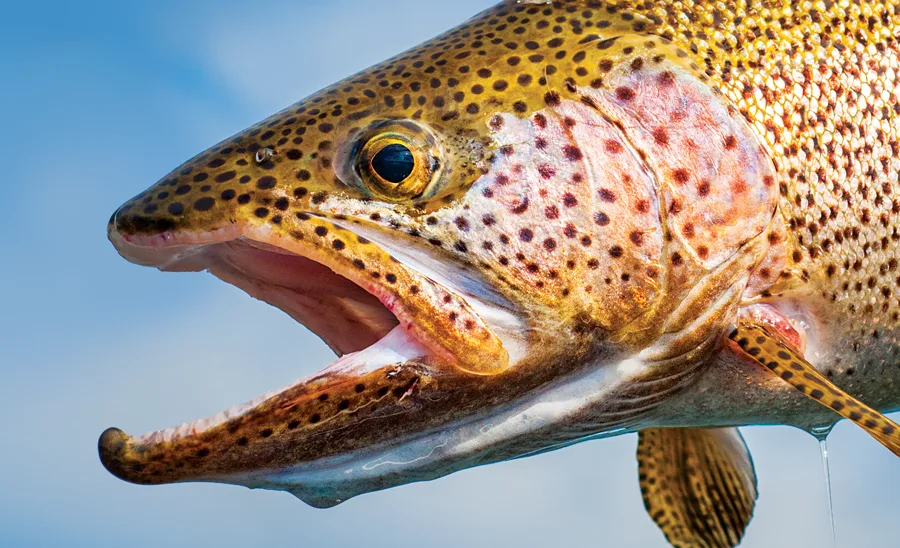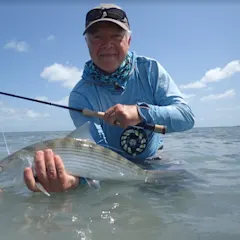Whether you arrive by floatplane, boat, or truck or with a pack on your back, we’ve found the greatest spots in North America to catch tons of fish, sleep under the stars, and have the time of your life.
Fish Camp By Truck
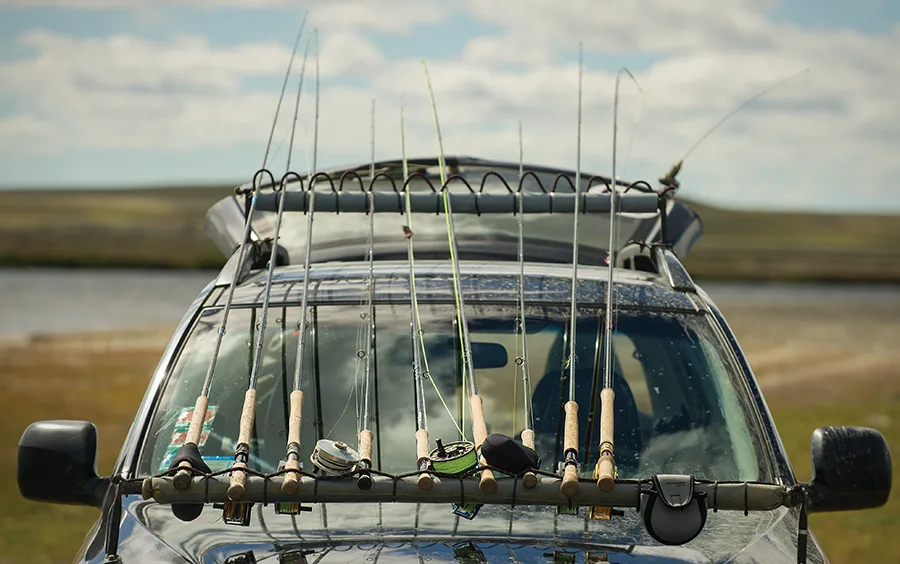
Whether you tent camp 10 feet from the tailgate or pull a fifth-wheel trailer, make a truck your base camp and you have a built-in fish cleaning station and picnic table, a bear-proof storage unit, and enough room to bring most of the comforts of home. And when you overhear a fishing tip at the camp shower, you can hightail it to the hot water. These destinations give you plenty of choices, including remote tent sites and RV resorts. Just make plans early. Many of these parks and campsites fill up months in advance, especially on summer weekends. —T.E.N.
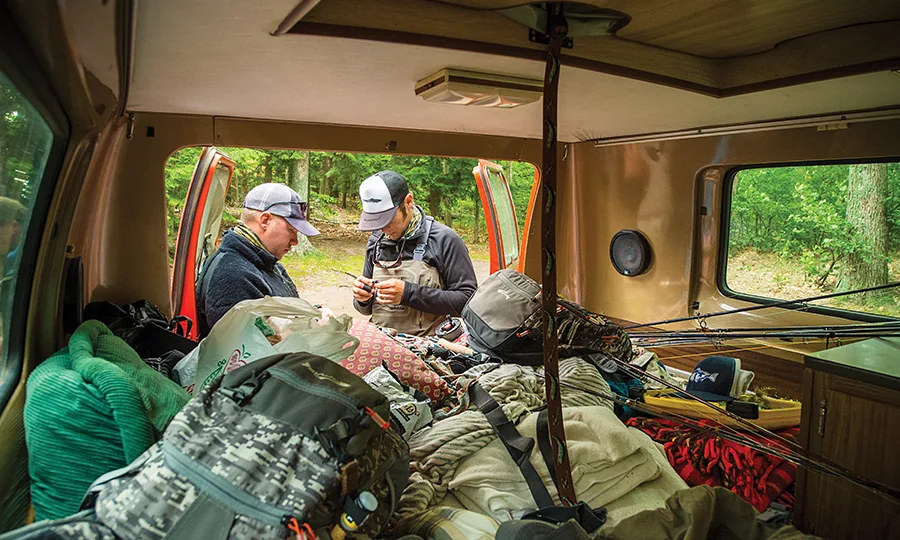
1. Alaska: Dalton Highway
This 414-mile gravel track parallels the Trans-Alaska pipeline from Livengood to the Arctic Ocean. You can camp practically anywhere and cast to Arctic grayling and Dolly Varden mere feet from the truck.
2. Alaska: Quartz Creek
Target rainbows that push 30 inches. Public campgrounds are located at Quartz and Crescent Creeks.
3. Arizona: White Mountains
There are only 12 sites at the South Fork Campground—all within a long cast of the South Fork of the Little Colorado River.
4. California: Sierra National Forest
Get your money’s worth from that lift kit on the OHV trails to Coyote Lake and Red Lake. Rainbow and brook trout thrive on the edge of the Dinkey Creek Wilderness.
5. Colorado: Eleven Mile Canyon
It’s a dry-fly angler’s dream tailwater stream, with trout packed into a narrow canyon. A dirt road parallels the river, and there are five Forest Service campgrounds from which to choose.
6. Colorado: Upper Colorado River
The river below Hot Sulphur Springs flows through a patchwork of BLM and Colorado state lands with tons of camping options and public access for trout.
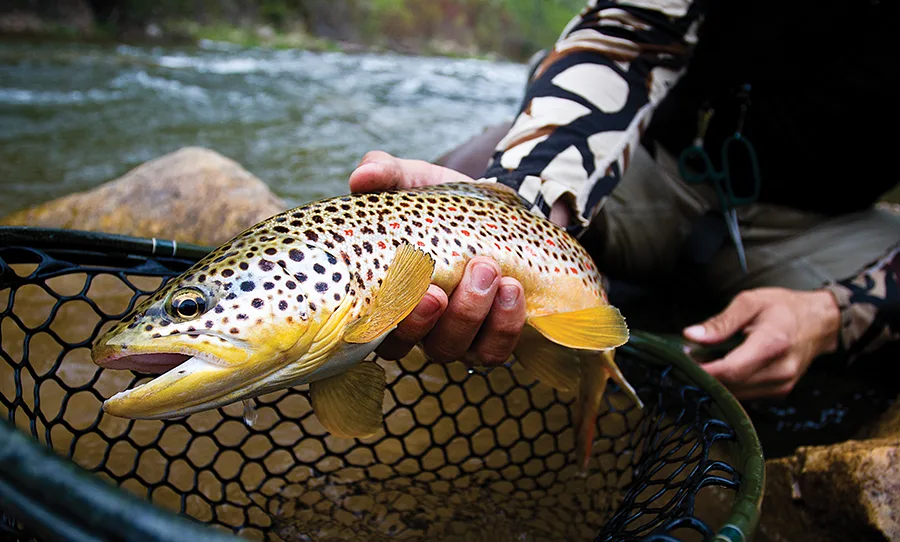
7. Florida: Overseas Highway
The 128-mile highway connects island to island all the way to Key West. Plan ahead for campsites and bring gear for flats and bridge fishing.
8. Florida: Suwannee River
This Southern icon is all about big sandy beaches on the lazy river and stringers of redbreast sunfish (a.k.a. redbellies). High winter water has pushed the Suwannee over its banks for the last few years, creating a smorgasbord for fish gorging before the spawn. Last year was the best season locals could remember, says Merel Pafford of Bowhunters Gun, Archery, Bait, and Tackle right outside of Old Town, Fla. “We had pound and pound-and-a-quarter redbellies in the store,” Pafford says. “Can’t imagine it won’t be just as good this year.” Crickets and mealworms work great, but last year Pafford brought in green worms that sent redbellies on a feeding tear. The best fishing is the three days before and after the full moon.
9. Maine: West Branch of the Penobscot
Target landlocked salmon on flies, in the monstrous North Woods of Maine, and set up base at the famed Chewonki Big Eddy Campground.
10. Missouri: Ozark Streams
The Ozarks pretty much have it all: pig browns in the tailraces, small-stream trout, muskies, ridiculously big bass. This summer, southern Missouri fly guide Brian Wise plans to work them all over with the Game Changer, a big, meaty articulated streamer. “It’s the fishiest fly I’ve seen in a long time,” he says. Wise will start stripping Game Changers for spring stripers and hybrids in the tribs of Norfork Lake, then chuck the bigger sizes for Ozark smallies and muskies. When early fall arrives, trout should fall prey. Plot your own Ozark trip in and around the Mark Twain National Forest.
11. Montana: Madison River
Stay at the Ruby Creek Recreation Area campground and work the Madison from Hebgen Reservoir to Ennis Lake.
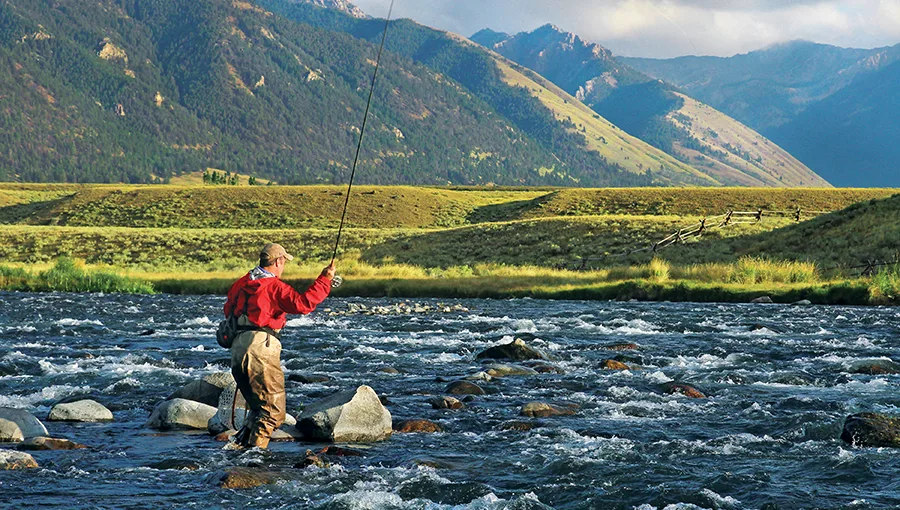
12. New Jersey & Pennsylvania: Delaware Water Gap National Recreation Area
The Delaware River delivers famed fishing, and American shad, smallies, and muskies top the list. You can camp at Dingmans Campground at Dingmans Ferry, Pa., or at Worthington State Forest Campground outside Columbia, N.J.
13. New York: Hither Hills State Park
A 2-mile sandy beach on Montauk gives you access to these famed striper waters.
14. North Carolina: Cape Lookout National Seashore
You and your 4×4 can be hauled by truck ferry across Core Sound to the Southern Outer Banks. Pitch a tent with the dunes at your back, build a fire below the high-tide line, and cast for redfish, bluefish, seatrout, and flounder.
15. North Carolina: Pisgah National Forest
The Pisgah has developed and commercial campgrounds and roadside pullouts. The rainbow, brown, and native brook trout fishing is among the best in the East.
16. Oklahoma: Lake of the Arbuckles
Not long ago, this 2,350-acre hog farm produced not one but two tournament entries of five largemouth bass totaling 40-plus pounds. There are private campgrounds aplenty, and public ones scattered through the Chickasaw National Recreation Area.
17. Rhode Island: Charlestown Breachway
What you see is what you get—water access to a striper-happy surf caster’s nirvana. No tents—just parking spots for 75 RVs—but it’s close enough to the water that you can lick salt from the air.

18. South Carolina: Santee-Cooper Lakes
The Santee-Cooper Lakes—Marion and Moultrie, with 450 miles of shoreline—hold crappies, stripers, largemouths, and cats.
19. Texas: Lake Fork
More than half of the 50 largest bass caught in Texas were from Lake Fork. Camping is just an excuse to be on the water quicker.
20. Texas: Padre Island National Seashore
With five public campgrounds, you are only minutes—or mere steps—from some of the South’s best surf and kayak fishing.
21. Utah & Wyoming: Flaming Gorge National Recreation Area
More than 700 campsites dot the region, anchored by the Flaming Gorge Reservoir with its possibilities of 40-pound lake trout.
22. Virginia & North Carolina: Blue Ridge Parkway
This 469-mile scenic highway provides access to some of the best rainbow, brown, and brook trout waters in the southern Appalachians.
23. Wisconsin: Chequamegon-Nicolet National Forest
Never heard of it? That’s the good news. Here’s more: 1,400 miles of trout streams, 607 lakes, and 400-plus spring ponds. Walleyes, trout, muskies, smallmouths. And it’s all yours, Mr. John Q. Public.
24. Wyoming: Gros Ventre Campground, Grand Teton National Park
Gros Ventre is a fine base camp for Snake River cutthroats, with more rivers to the south and Yellowstone to the north.
25. Wyoming: Soda Butte
Soda Butte Campground in Gallatin National Forest is the gateway to the less trampled northeastern side of Yellowstone Park. Hit Soda Butte Creek right on the roadside, then day-hike into some of the Gallatin’s 700 high mountain lakes and reservoirs.
Fish Camp by Float Plane
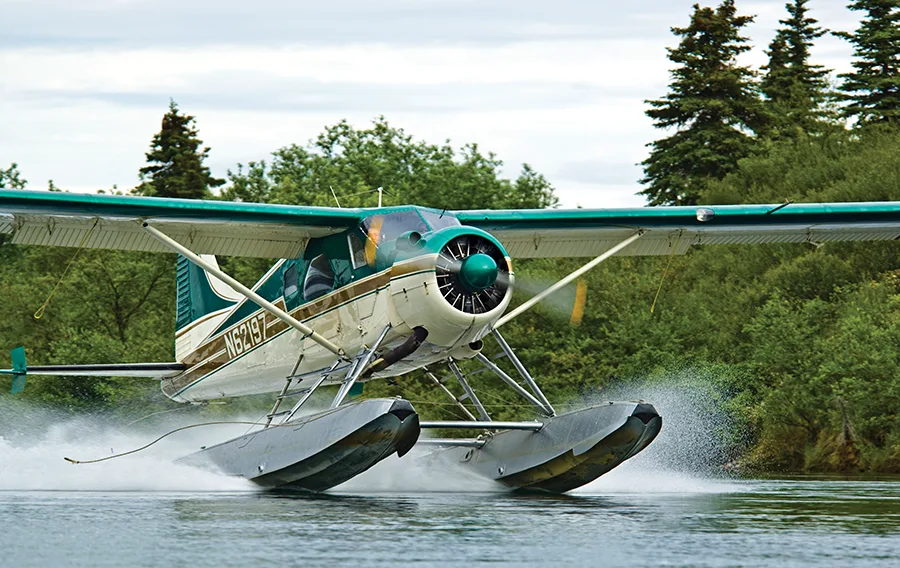
A short ride on a small plane can take you to some of the quietest—and best—fishing camps in the world, where the closest neighbor could be a curious bear or calling loon, and the setting is gorgeous from every casting angle. One thing you won’t encounter is fishing pressure. Fly-in anglers are often the only ones on the water, which means you’re targeting fish that have seen very few, if any, lures or flies. Getting to the destinations listed here may be more expensive—and intensive—than a drive to the local lake, but in an increasingly noisy world, finding this kind of solitude is priceless. —D.D.
26. Alaska: Fish Creek Cabin
This spot is one of Southeast Alaska’s best D.I.Y. fishing camps for both fresh- and saltwater anglers. Fish up the creek for steelhead and Dolly Varden, or venture out into the Thorne Arm to target halibut, rockfish, and salmon.
27. Alaska: Italio River Cabin
This little Forest Service A-frame sits just 3⁄4 mile up from the mouth of the Middle Italio River—a prime location for a big run of silver salmon starting in mid September. You can book a flight with Yakutat Coastal Airlines.
28. Alaska: Rapids Camp Lodge
Pat Stefanek has guided anglers on many of Alaska’s major fisheries, but now he leads flyfishing trips to Rapids Camp Lodge on the NakNek River. He tries to time his visits for mid June, when predatory rainbow trout bust salmon smolt on the surface. “You watch for birds and bait on top, then cast a pencil popper or surface smolt pattern into the middle of it and hold on,” says Stefanek. “It’s like saltwater fishing, but for rainbows.” Stefanek’s go-to rod for these trout, which go into double digits, is a 9-foot 8-weight.
29. Alaska: Tikchik Narrows Lodge
Luxurious accommodations meet unparalleled variety in the Bristol Bay watershed at this wilderness lodge. Daily flights take you to the region’s famed salmon and trout fisheries, including the Nushagak River, or you can cast for cohos and grayling from camp.
30. Alaska: Wulik River
In fall, this river north of the Arctic Circle fills with some of Alaska’s largest sea-run char and holds trophy grayling as well. Pack a stout rod and bear spray because grizzlies aren’t an uncommon sight here.
31. Bahamas: Flamingo Cay
Some of the world’s best bonefishing is on Andros Island’s west side, where this is one of the only lodges available. Don’t forget to enjoy some conch fritters and a few cold bottles of Kalik.
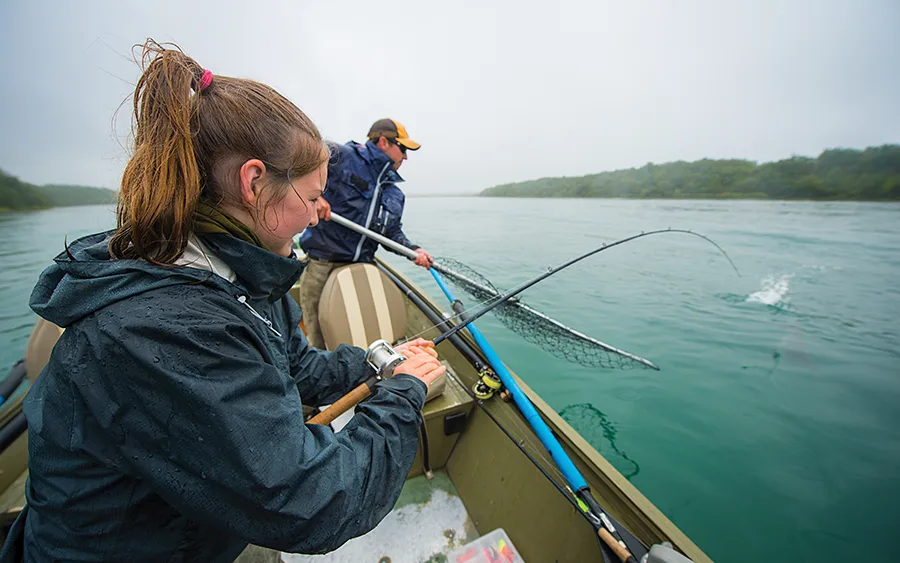
32. British Columbia: Lower Dean River Lodge
Just 8 miles from the salt, this newly rebuilt lodge offers access to fresh-from-the-sea steelhead from June to October. Later in summer, cohos and chinooks compete for your attention.
33. Florida: Dry Tortugas National Park
Be sure to secure your landing permit, and campsite, ahead of time at this historic archipelago. There’s great fishing from shore, or strap a kayak to your floatplane to tackle deeper water.
34. Idaho: Cabin Creek Airstrip
Hire an air taxi to take you into one of the most remote and wildest places in the Lower 48—the Frank Church–River of No Return Wilderness, to fish for cutthroat trout in Big Creek.
35. Manitoba: North Seal River
Explore Egenolf Lake from the lodge at the mouth of the river or fly out to one of 26 different lakes managed by the Gangler family (ganglers.com) to land a Canadian Grand Slam: lake trout, northern pike, walleye, and grayling.
36. Manitoba: Nueltin Lake
Fly from Nueltin Lake Lodge to one of the 715-square-mile lake’s many inlets, where trophy grayling await.
37. Manitoba: Whiskey Jack Lake
At Jackson’s Lodge and Outposts, you’ll have all you need: a small cabin, a long dock, and a pair of 14-foot boats at your disposal to fish Whiskey Jack and Hallen Lakes, both of which hold the day’s essential shore-lunch ingredient—fresh walleye.
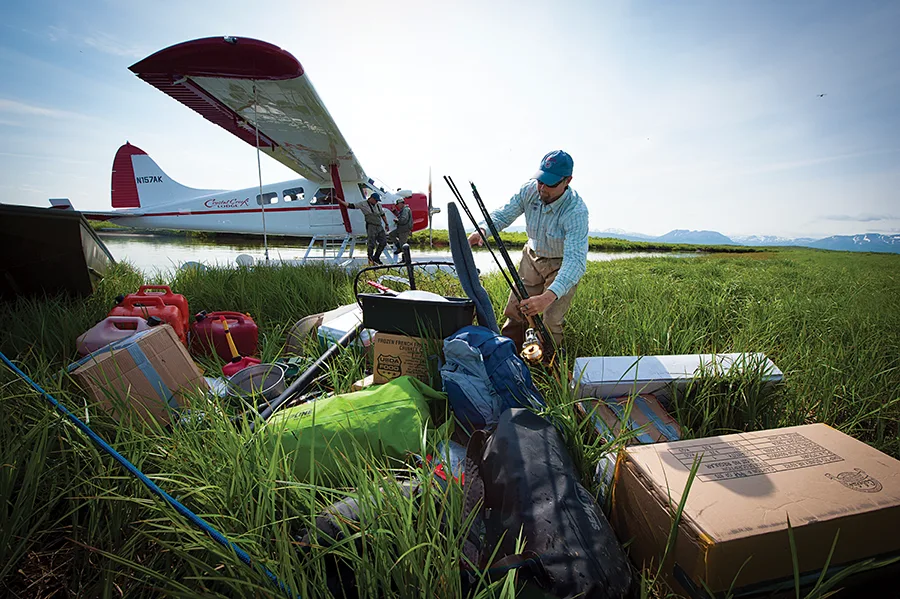
38. Michigan: Isle Royale National Park
Ninety-nine percent of this Lake Superior archipelago, which you can reach only by floatplane or ferry, is designated wilderness, with 165 miles of foot trails that access both Superior and inland lakes. Cast for brookies, lake trout, and northern pike on waters as wide open as 7-mile-long Siskiwit Lake to tiny beaver ponds and streams.
39. Mississippi: Gulf Islands National Seashore
Speckled trout and bull redfish run bait into the shallows of these barrier islands that are just a 15-minute ride by seaplane from the mainland.
40. Montana: Great Bear Wilderness
A small airstrip at Schafer Meadows is your starting point for a float trip down the Flathead River targeting native Westslope cutthroat trout. To book your getaway, contact Glacier Raft Co.
41. Montana: Russian Flat
This former grassland turned grass airstrip in Lewis and Clark National Forest provides access to brookies, browns, and rainbows in the South Fork of the Judith River. Camp in the corral or take a hike to the developed campground above Russian Creek.
42. Newfoundland: Little Minipi River
The entire Minipi system is well known for its big brook trout, but this remote watershed is the perfect place to map out a solitary river outing from your rustic outpost at Minipi Lodges.
43. Northwest Territory: Aylmer Lake
With just a short eight-week season and no commercial netting, Aylmer Lake Lodge (aylmerlakelodge.com) seems destined to give up the next world-record lake trout. To up your odds, lodge owner Kevin McNeil says to go big and go slow. “We target trophies with big plugs like the T-60 Flatfish in chartreuse or white,” says McNeil. “We search for larger fish hanging on submerged reefs in 5 to 15 feet of water and troll wide, slow S-turns over them until they strike. That fish may not have seen another lure in its entire life.
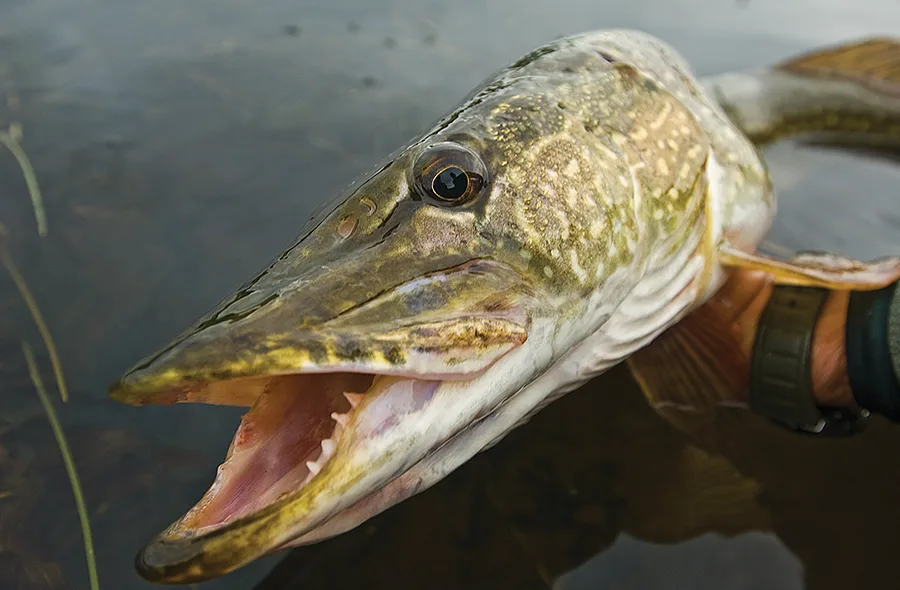
44. Nunavut: Ekaluk River
For a short window in late August, more than 80,000 bright Arctic char enter the Ekaluk River. B&J Flyfishing Adventures, a remote outpost 300 miles into the Arctic, serves as base camp for anglers chasing a record.
45. Ontario: Quetico Park
The first leg of this multiday adventure is a flight to Clay Lake (canoetrip.com). From there you’ll paddle and portage as you fish your way back to base camp via several lakes and rivers filled with big walleyes, bass, and pike.
46. Ontario: Wabakimi Lake
Deep inside Wabakimi Provincial Park, its namesake lake is 20 miles long with enough shoreline and submerged reefs to keep anglers busy chasing walleyes and trophy pike. Northern Wilderness Outfitters (northernwilderness.net) can set you up with flights, lodging, and guides.
47. Quebec: Pilodeau River
A spartan camp on Lake Guenyveau (ungava-adventures.com) is your base for exploring this waterway. In late summer, anglers can intercept big sea-run char coming upriver to spawn.
48. Turks and Caicos: Salt Cay
Ditch the Caribbean crowds at this remote outpost. A short drive from the runway, you’ll find untouched beaches and plenty of bonefish within casting range.
49. Washington: Lake Isabel
Accessible by seaplane, this subalpine lake in the Cascades has an abundance of big lake trout. Go for plugs or jigs in white or chrome to imitate the juvenile kokanee that lakers love.
50. Washington: Sullivan Lake
While not exactly in the hinterlands, a Forest Service campground and a 1,200-acre lake filled with kokanee salmon and burbot make this well worth the hop from SeaTac, Wash.
Fish Camp by Backpack
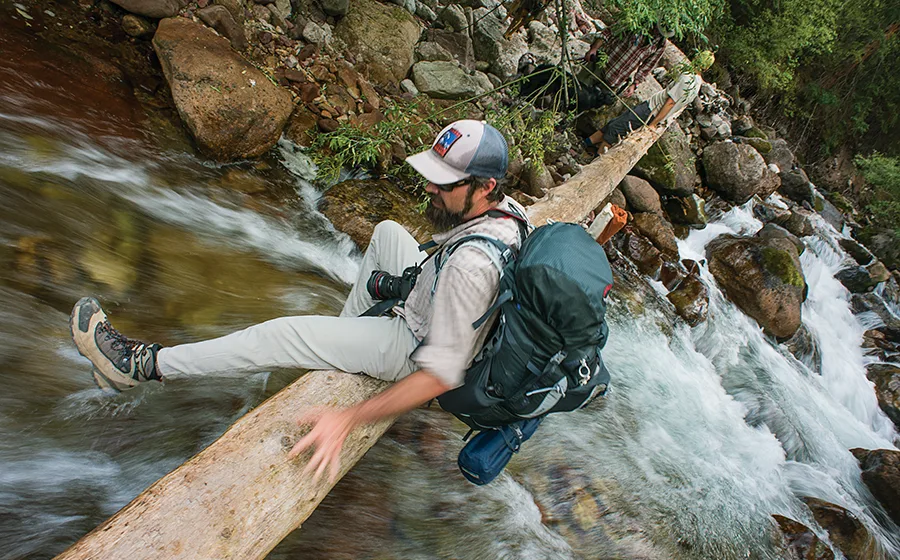
No pain, no gain—or, in this case, no panoramic vistas of alpine lakes, no streamside campfires, no rolling out of the sleeping bag and casting for a breakfast trout 20 feet away. That’s the accepted calculus of backpacking into wild fish country—pay your dues, and the payoff is solitude, serenity, and the best fishing in America. It’s a sweet deal, and here’s the best part: Fishing camps like this are not all in the West, and they’re not all about trout. Here’s a wish list of the best backcountry fishing spots across the country, from mountains to deserts to bogs to salt marsh. It’s all public land. Hit the treadmill, then get after it. —T.E.N.
51. Alaska: Gates of the Arctic National Park
Fishing for grayling, lake trout, and char can be beyond belief, but you have to work to get there. There are no established trails, but for wilderness junkies, this is the Big One.
52. Arkansas: Buffalo River
This Ozark gem is full of nice smallmouth and largemouth bass, with some of the best river-shore camping you’ll find anywhere in the country.
53. Colorado: Flat Tops Wilderness
Put in the effort to climb the plateau, and your reward is relatively flat tableland pocked with trouty lakes chock-full of cutthroats.
54. California: John Muir Trail
This one’s a whopper: a 210-mile trail that passes through Yosemite, Kings Canyon, and Sequoia National Parks. It also crosses brook, brown, rainbow, and golden trout water.fish like a local
55. Colorado: Rocky Mountain National Park
Steve Schweitzer, author of A Fly Fishing Guide to Rocky Mountain National Park, suggests you show up to this iconic backcountry with beefy flies. His fly box holds caddis, bluewings, and other standards, but it is also stuffed with terrestrials. “When trout finally see ice-free water, they’re going after ants and hoppers,” he says. “Some alpine waters don’t open up until well into summer, and by then, the big bugs are out.” His go-to flies: Dave’s Hopper, Amy’s Ant, and the Flip-Flop Ant. With a 4-weight, Schweitzer uses a dapping technique with no more than two rod lengths of line, stalking streams and pond shores.
56. Georgia & Tennessee: Cohutta–Big Frog Wilderness
More than 40,000 remote Appalachian acres straddle the state line, with a pair of trout rivers—the Conasauga and the Jacks.
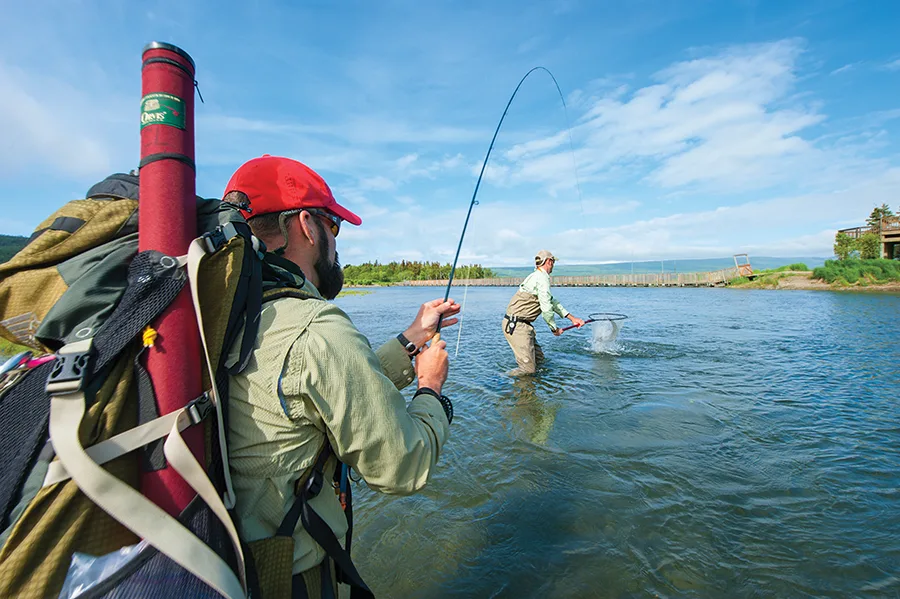
57. Georgia: Cumberland Island National Seashore
Campsites on the island’s north end are more remote and close to the best fishing—including a shot at a redfish dinner.
58. Kentucky & Tennessee: Big South Fork National Recreation Area
The river floodplain is open to camping, so hoof it to the bottom and cast for smallmouths, largemouths, catfish, and walleyes.
59. Maine: Baxter State Park
Fishing for pond brookies is a staple of the Maine experience, and Baxter’s 200,000 acres are stippled with backcountry waters.
60. Maryland & West Virginia: Chesapeake & Ohio Canal National Historical Park
Averse to altitude gain? Happy to whack a smorgasbord of trash fish (carp), trophy fish (bass), and exotic aliens (snakeheads)? Head East. The canal runs for 184 miles along the Potomac River, with campgrounds every 6 to 8 miles.
61. Michigan: Porcupine Mountain Wilderness State Park
The Porkies take in 60,000 acres of virgin timber, river gorges, and wide open lakeshore. Try the Big Carp or Little Carp Rivers for a killer brookie bite.
62. Montana: Absaroka-Beartooth Wilderness
Nearly a million acres of wilderness sprawls just north of Yellowstone, with trail access to creeks and lakes that hold brook trout and cutts.
63. Montana: Bob Marshall Wilderness
The Bob spans more than 1 million of the best acres in the West. Outfitters make it possible to mix up a trip: Horse-pack in, raft out, or walk it all.
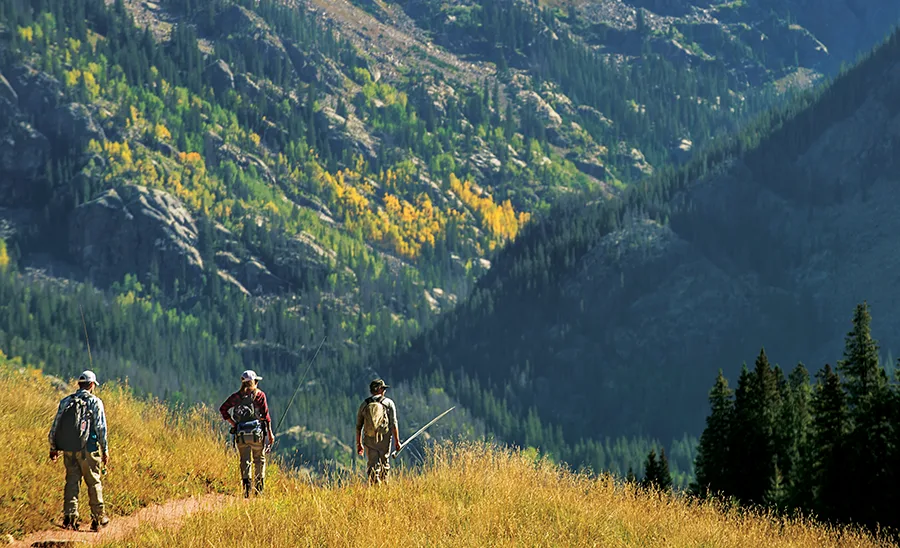
64. New York: Adirondack Park
If you have the quads for it, strap a float tube and waders to your pack and pond-hop in the Five Ponds and Pharaoh Lake wilderness areas.
65. North Carolina: Hazel Creek
One of the most famous trout streams in Great Smoky Mountains National Park, Hazel Creek tumbles through a valley studded with mossy boulders and carpeted with wildflowers.
66. North Carolina: Nantahala National Forest
In Cherokee, Nantahala means “land of the noonday sun,” a reference to the steep, deep valleys where miles of fine trout water flow under a dense rhododendron canopy. Matt Maness, who guides for Foscoe Fishing in North Carolina, uses a sweep-and-punch style of fly casting to thread a back cast into a targeted opening in the overhead stream canopy, then redirects the forward cast at an angle to put the fly on the water. First, Maness says, lay out a short roll cast. Look over your shoulder, find the clearing in the streamside vegetation, and firmly sweep the rod tip up and toward the opening. “You have to stop the rod tip sharply to get a tight back cast to loop into the opening,” he says. When the line straightens out behind you, square your shoulders away from the back cast and toward your target. “Now make a simple forward cast.”
67. Oregon: Hells Canyon
Save a few thousand bucks on raft outfitter fees and hump it into Hells Canyon by foot for summertime trout and fall steelhead.
68. Oregon: Wenaha River
Thirty miles of trail parallel the river, which drains a roadless swath of the Blue Mountains upstream of the Wenaha’s confluence with the Grande Ronde. Fish for rainbow and bull trout in late spring and summer, then target steelhead in fall.
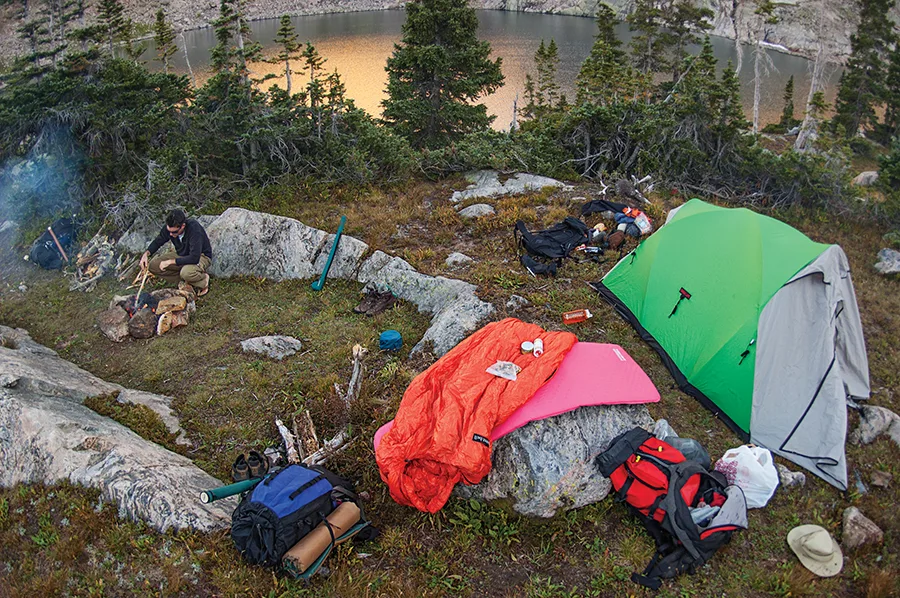
69. South Carolina & North Carolina: Jocassee Gorges
Four mountain rivers spill into Lake Jocassee. It’s rugged country, but the Foothills Trail accesses very good brown trout water in the Thompson and Whitewater Rivers.
70. Utah: High Uintas Wilderness
Nearly a half million acres of Utah’s highest peaks are scored with glacier-fed trout streams. Be sure to bring mosquito nets.
71. Virginia: Shenandoah National Park
You have to work to access headwater streams, and the cascading, waterfall-studded creeks of the Shenandoah are top-shelf. Don’t wait till the dog days, though. The trout fishing slows in these small streams once the water warms.
72. Washington: Olympic National Park
The park has 4,000 miles of streams, 602 lakes, and 70 miles of rugged shore. Much of it is severe country, which usually equals hungry, willing fish.
73. West Virginia: Cranberry Wilderness
Once impacted by acidification, the Cranberry River is again a fine trout stream, thanks to the addition of limestone drums to buffer the water.
74. Wyoming: Wind River Range
More than 300 alpine lakes in the Winds were seeded with trout in the 1930s, and today the self-sustaining populations attract hardcore backcountry anglers.
75. Wyoming: Yellowstone National Park
The Bechler River area is far from the madding crowds in the park’s southwestern Cascade Corner. It’s also very clear, so bring your casting A game for these wild trout.
Fish Camp by Boat

I inherited my great-grandfather’s johnboat almost 30 years after he died. He towed that thing to Canada every summer to fish, camp, and eat fresh, battered fillets fried in recycled Crisco. I never imagined the world the boat would open up. There’s something about a fishing boat that awakens the inner explorer—that desire to drive around the next point because you know the fish have to be there. And if they aren’t? Just move to the other side of the lake. Combine that freedom to cover lots of water with a comfortable base camp, and you’ve got the makings of an epic expedition. —B.R.
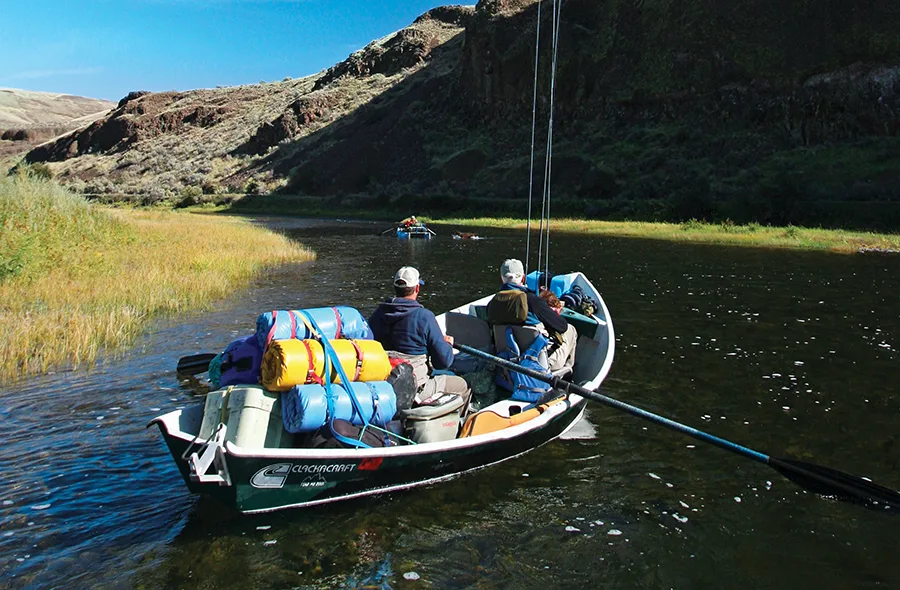
76. Alaska: Kanektok River
Charter-air services from either Bethel or Dillingham can deliver your crew and gear to the headwaters. From there, you float, camp, and fish for salmon, trout, and Dolly Varden through the Togiak National Wildlife Refuge until you reach the Bering Sea at Quinhagak.
77. Arkansas: White River
Bull Shoals State Park has tent and RV campsites, boat rentals, and access to one of the U.S.’s greatest tailwater fisheries for giant brown and rainbow trout.
78. California: Clear Lake
Anglers repeatedly rate this lake as one of the best largemouth fisheries in the West. There’s a state park with a boat ramp just north of the town of Kelseyville, and two privately run campgrounds on the south and southeastern shorelines.
79. Georgia: Lake Lanier
The U.S. Army Corps of Engineers maintains nearly 500 campsites around the lake, all within a stone’s throw of a boat ramp. It’s one of the South’s most popular lakes, thanks to the strong numbers of bass, crappies, bluegills, and more.
80. Idaho: Middle Fork Salmon River
Apply and draw a USFS permit to launch, and you’ll likely connect with more cutthroat trout than you can count along this 112-mile, camp-as-you-go float.
81. Illinois: Illinois River
Jumping Asian carp are on most bowfishermen’s bucket list, and this river is full of them. There are boat ramps and state park campgrounds north and south of Peoria.
82. Tennessee & Kentucky: Land Between the Lakes
With 170,000 acres of public land, 300 miles of undeveloped shoreline, boat ramps, campsites, and warmwater fishing in three different systems, this recreation area has something for any angler.
83. Maine: Allagash Wilderness Waterway
This 92-mile-long system of streams, rivers, ponds, and lakes offers good canoeing and fishing for brook trout. It gets buggy in summer, but there’s good fishing and solitude at one of the many campsites along the way.
84. Michigan: Beaver Island
Surrounded by some of the best smallmouth and carp flyfishing action in the state, this island has two campgrounds: the St. James Township Campground and the Bill Wagner Memorial Campground.
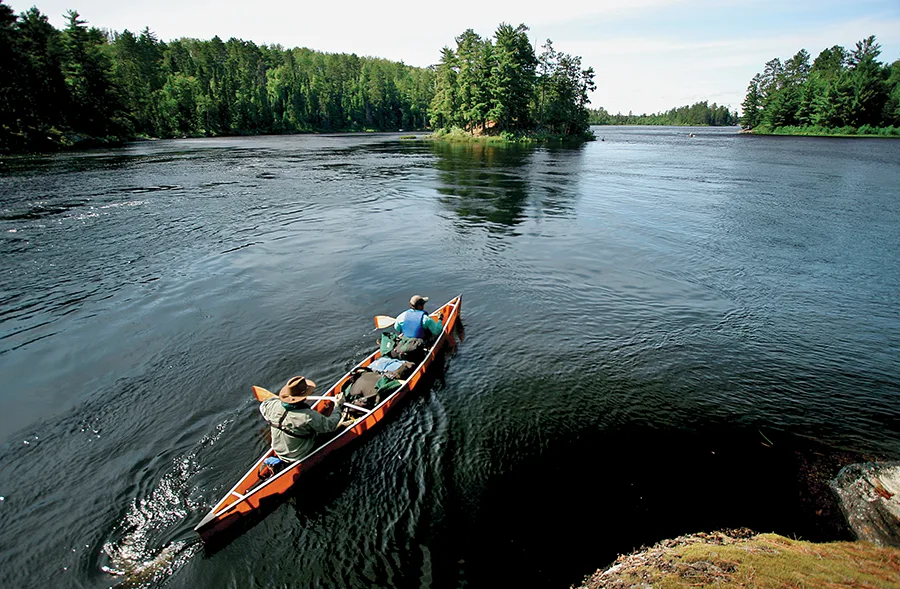
85. Minnesota: Boundary Waters Canoe Wilderness
The more distance you travel (and portage) in this iconic spot, the fewer people you’ll see and the better walleye, pike, and bass fishing and camping you’ll find.
86. Minnesota: Lake Vermilion
Vermilion is a structure fisherman’s dream. Replete with islands, bays, and weedbeds, it’s a favorite for walleyes, bass, and pike. Primitive, boat-in-only campsites are available through the state’s DNR.
87. Montana: Fort Peck Reservoir
Here you’ll find pike, lake trout, bass, and terrific walleye action. On the lake’s south side, check out Hell Creek State Park. On the north side, there’s the Fort Peck West Campground.
88. Montana: Missouri River
One of the best tailwaters in the West, the Mo is easy to row in a drift boat or raft. Expect to share the water—no matter the season. There are campgrounds above and below Holter Dam.
89. Montana: Smith River
The Smith is one of Montana’s best rivers for a multiday fishing and camping trip. (Note: The permit-application deadline is typically the second week of February.)
90. Nevada: Lake Mead
Year after year, this lake garners more attention as a great largemouth and striped bass spot. There are public campgrounds, though anglers can also camp on the shoreline.
91. New York: St. Lawrence River
The Thousand Island region is a maze of islands, inlets, and coves with fishing for bass, pike, and muskies. Camp at Wellesley Island State Park.
92. Oklahoma & Texas: Lake Texoma
Texoma has killer largemouth, smallmouth, and striped bass fishing. Texas’s Eisenhower State Park has great camping and facilities.
93. Ontario: Algonquin Provincial Park
While lakers, smallies, and walleyes are abundant, this park is home to one of the last wild brook trout strongholds. The biggest fish are in the backcountry, reachable only by canoe.
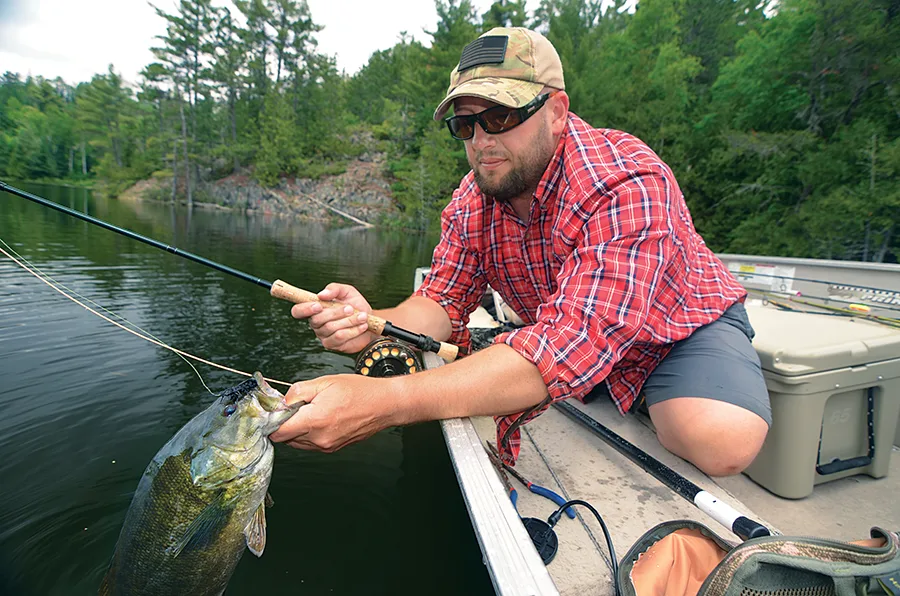
94. Ontario: Pipestone Lake
Pipestone Lake is a rare place that feels like a remote fly-in destination but is accessible by boat. There are perch, bass, and muskies, but most anglers come for the lake trout and walleyes.
“Late spring and early summer is a great time because the water is warming up,” says Todd Baker, owner of Cedar Island Lodge (cedarislandlodge.com). “Baitfish are migrating to shallow water, and the big fish will be right behind them. We find lake trout and walleyes in less than 10 feet of water. Troll a chartreuse-and-white original Rapala through the bays that have a relatively consistent depth. Avoid the steep peninsula points where there’s no structure and the water drops off. The water is colder, and there’s nothing there to attract fish.”
95. Oregon: John Day River
The John Day is one of the West’s finest and most remote smallmouth rivers. Boaters must obtain a BLM permit before launching, but the stretch from Clarno to Cottonwood Canyon Bridge is a good bet for solitude and good fishing. Get the John Day Recreation Guide from the BLM for information on campsites, as most of the river weaves between public and private land.
96. Oregon & Washington: Grande Ronde River
The lower river runs through the arid, desolate canyons of eastern Oregon and Washington and is a smallmouth bass stronghold. Purchase the Wallowa and Grande Ronde Rivers Boater’s Guide to find the best campsites.
97. South Dakota: Missouri River
You’ll find plenty of water, walleyes, white bass, and pike in the stretch between Pierre and the state’s northern border. Public camping and boat ramps are plentiful along the eastern shoreline, too.
98. Texas: Colorado River
The lower Colorado River has strong numbers of bass (including the river-specific Guadalupe bass), gar, and carp. There are a few public riverside campgrounds between Austin and the Gulf, perfect for canoeists.
99. Wisconsin: Apostle Islands
Camping is allowed on 18 of this national park’s 21 boat-accessible islands, though it’s wise to reserve a site in advance. Once you’re there, you can explore Lake Superior’s big water for steelhead, lake trout, and bass.fish like a local
100. Wisconsin: St. Croix National Scenic Riverway
The upper St. Croix River and the Namekagon River are part of the 225-mile system, with both primitive and maintained (first come, first served) campsites. They’re also home to some of the state’s best smallmouth and muskie flyfishing.
For fly anglers hoping to land a muskie, this is a great place to do it. Hayward Fly Fishing Co. co-owner Larry Mann recommends that you bring a heavy rod, put less faith in pattern selection, and be ready for a workout. “Most anglers worry about fly patterns when it comes to chasing muskies,” Mann says. “But it’s really about stamina—can you cast all day long? Catching one simply takes time, and if you run out of gas, you’re out of the game. Most anglers are used to throwing small dry flies on a 4- or 5-weight, which is not the same as throwing the family dog on a 10-weight.
“The rivers are part of the National Wild and Scenic program, so when a tree falls into the river, it stays there if it’s not impeding navigation,” Mann notes. “But that makes for some great fish-holding structure. Look for fish to be holding around undercuts, downed trees, around rocks and riffles, and all the places that you’d expect to find bass and muskies lurking in moving water.”

